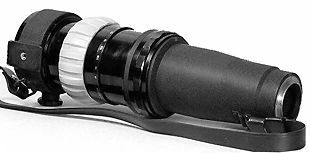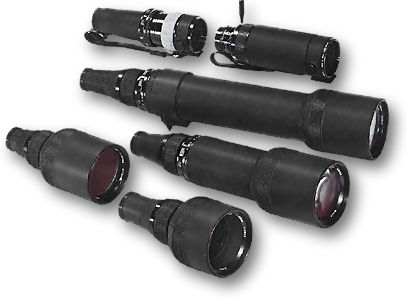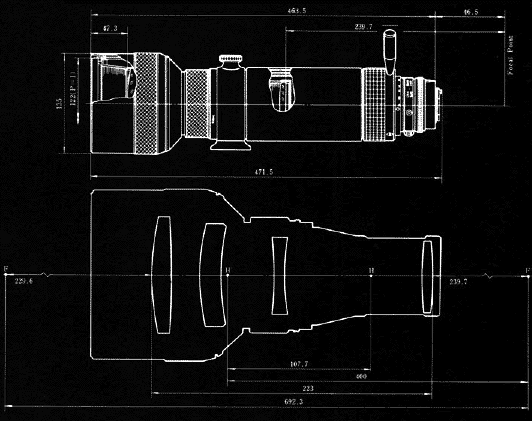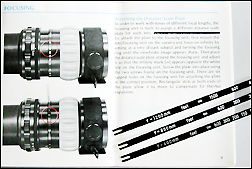Nikon Focusing Unit CU-1 & AU-1
 |
The Focusing Unit is an intermediate tube that is placed between a camera and any one of the Nikkor 400mm, 600mm, 880mm and 1200mm super telephoto lenses. It has a focusing device and an automatic diaphragm with click-stops at f/4.5, f/5.6, f/8, f/11, f/16 and f/22. (The automatic aperture cannot be used with the 1200mm lens*). The maximum f-number on the focusing unit depends on the lens used. |
 |
Two types of focusing units - the Nikon Focusing Unit AU-1 and the conventional Nikon Focusing Unit - are available. The AU-1 unit accepts the Nikon standard 52mm filter inside the unit, and it is compact and easy to handle since essential controls are conveniently placed close to the camera body. With the conventional Focusing Unit, a 122mm filter is attached to the front of each lens. Two part telephotos use a common Focusing Mount Adaptor (B). Its principle works something like camera mounts on the lens, while the lens mounts on a tripod - the advantage of the unit is being - the entire lens rotates in its mount so you can turn the camera conveniently from vertical to horizontal or vice versa. |
 |
Credit: Image(s) displayed
herein courtesy of all the nice folks from Taiwan's
Digitize-Future@EBAY®. Some of them are
extracted from their very popular
online EBAY STORE.
The Company also has a website on their own at shueido.com Image(s) copyright © 2006. All rights
reserved. Please respect the visual property of the contributing photographer. CLICK FOR AN EXPLOSIVE VIEW(S) from Thumbnail(s) Below |
 |
 |
 |
 |
Also popularly referred as "two parts" telephoto lenses. The first series of Nikkor super-telephoto lenses with focal length from 400mm and above were designed into two sections which comprised of a focusing unit and lens head on another. The theory of lens designers (Not just Nikon, others such as Canon etc. used similar concept) thought such design can made a standard focusing unit for common use of those long super telephoto lenses with the convenience of only changing the lens heads wherever it requires without physically changing a entirely lens. CU-1, this improved mobility and especially in situations where a tripod or other film support is constantly required to hold such heavy optic. So, on the camera section, a focusing unit mounts which contains an automatic diaphragm and a focusing mechanism and it will accept individual lens heads which has the optical glass within.
Credit: ALL Images of the 600mm f5.6 Nikkor-P with Nikon Focusing Unit displayed in this site courtesy of Ebay - Mathew Duren<<ebay@adorama.com> http://www.ADORAMA.com Copyright © 2003.
 |
* Nikon has designed two versions of the original focusing units for those older super-telephoto lenses thus far. The Focusing Unit CU-1 Model 1 and Model 2 has an integrated aperture, a gray colour wide grip ring for focusing with a tripod clamp. Main difference between Model 1 and Model 2 is the colour of the focusing grip with the latter finished in matte black. Both model 1 and model 2 has F-bayonet type Mount on the camera side and a 88mm screw-in type mount on the lens section. The longest reaching Nikkor 1200mm cannot be used in automatic aperture control via the two units. |
However, with the introduction of the ED series of Nikkor super telephoto lens heads such as Nikkor 600 f/5.6 ED, Nikkor 1200mm f/11 ED a completely new design of the focusing unit, AU-1 was introduced to enable better compatibility with such lenses. The focusing ring of the AU-1 has a built-in aperture control from f/4.5 to f/22. Unlike the odd looking focusing ring found on earlier model(s), the AU-1's focusing ring uses a hard rubberized 5 rows rectangular texture found on late Nikkor lenses. A small lever can be screw-in near the focusing ring for better focusing control and handling. There are coloured markings to remind users to set the appropriate setting when use with lenses of different focal length. Red - 400mm, yellow - 600mm, Green - 880mm and blue - 1200mm. These are again inscribed on the distance scale in two sets of values: 400-600mm in one group and 600-1200mm in another. The tripod clamp can be adjusted swiftly for horizontal or vertical format shooting. Another improvement of the AU-1 is, it uses 52mm filters which can be inserted into the focusing unit but CU-1 Model 1 and Model 2 do not have such feature and thus, it may require the user to use 122mm filter screw into the front of EACH of the lens head. Overall, the AU-1has a much improved design and handling than earlier model 1 and Model 2 units.
|
Each super telephoto lens comes with a removable distance scale, which can be detached or attached to the focusing unit by means of screws. A large scalloped focusing ring is easy to grip when focusing. The unit is also supplied with a shoulder strap for carrying ease. An accessory cradle for the focusing unit which provides a firm support to the total unit for smoother focusing is available on order. The tripod socket on a revolving collar allows selection of vertical or horizontal picture format while the entire unit is mounted on a tripod.
 |
Comparing size and dimension of a typical Nikkor 400mm f/4.5 telephoto lens head with a companion AU-1 unit. |
Specification of a Nikon Focusing
Unit Model 1 (model 2):
Mount: F-bayonet type (camera side) 88mm screw-in type (lens side) |
Nikkor
Super Telephoto Lenses -
|
300mm | 400mm | 500mm | 600mm | 880mm | 1200mm | Reflex - 500mm 1000mm 2000mm
Nikkor
300mm f/2.0s EDIF
| Nikkor
300mm f/2.8s EDIF
| Nikkor 300mm f/2.8 EDIF |
Pre-AI
Nikkor 300mm f/2.8 ED Preset | Non-AI Nikkor 300mm f/2.8 Preset |
Nikkor
300mm f/4.5s EDIF
| Nikkor 300mm f/4.5 EDIF |
Nikkor
300mm f/4.5 ED
| Pre-AI Nikkor 300mm f/4.5 ED |
Nikkor
300mm f/4.5s | Nikkor 300mm f/4.5 |
Pre-AI
Nikkor 300mm f/4.5 | Non-AI Nikkor-H 300mm f/4.5 | Non-AI
Nikkor-P 300mm f/4.5
| Nikon Focusing Unit AU-1 | Original Focusing
Unit | N/F Tube
| Message Board |
for
your Nikkor
Optics
in a shared environment
| Message
Board
| Specifically for Dispose or Looking for new/used Nikon/Nikkor
photographic equipment
| Nippon Kogaku Rangefinder Resources | Nikon F | Nikon F2 | Nikon F3 | Nikon F4 | Nikon F5 | Nikon F6 | Nikkormat / Nikomat | Nikon FM Series | Nikon FE/ FA | Nikon EM/FG/FG20 | Nikon Digital SLRs | Nikon - Other models |
Nikon MF RF-Nikkor lenses for Rangefinder
cameras:-
Main Index Page
Nikon
Auto Focus Nikkor lenses:- Main
Index Page
Nikon
Manual
Focus
Nikkor lenses:-
Fisheye-Nikkor Lenses - Circular |
Full Frame |
Ultrawides Lenses - 13mm15mm18mm20mm |
Wideangle Lenses - 24mm28mm35mm |
Standard Lenses - 45mm 50mm 58mm | Telephoto Lenses
- 85mm105mm135mm180mm & 200mm |
Super-Telephoto Lenses - 300mm 400mm 500mm 600mm 800mm 1200mm |
 |
Special Application
lenses: Micro-Nikkor Lenses - 50mm~55mm -60mm 85mm -105mm 200mm Micro-Zoom 70-180mm Perspective Control (PC) - 28mm 35mm PC-Micro 85mm Dedicated Lenses for Nikon F3AF: AF 80mm f/2.8 | AF 200mm f/3.5 EDIF Depth of Field Control (DC): 105mm 135mm Medical Nikkor: 120mm 200mm Reflex-Nikkor Lenses - 500mm 1000mm 2000mm Others: Noct Nikkor | OP-Nikkor | UV Nikkor 55mm 105mm | Focusing Units | Bellows-Nikkor 105mm 135mm Nikon Series E Lenses: 28mm35mm50mm100mm135mm | E-Series Zoom lenses: 36~72mm75~150mm70~210mm |
MF Zoom-Nikkor Lenses: 25~50mm | 28~45mm | 28~50mm | 28~85mm | 35~70mm | 36~72mm E | 35~85mm | 35~105mm | 35~135mm | 35~200mm | 43~86mm | 50~135mm | 50~300mm | 70~210mm E | 75~150mm E | 80~200mm | 85~250mm | 100~300mm | 180~600mm | 200~400mm | 200~600mm | 360~1200mm | 1200~1700mm
Tele-Converters: TC-1 | TC-2 | TC-200 | TC-201 | TC-300 | TC-301 | TC-14 | TC-14A | TC-14B | TC-14C | TC-14E | TC-16 | TC-16A | TC-20E
Recommended links to understand more technical details
related to the Nikkor F-mount and production Serial Number:
http://rick_oleson.tripod.com/index-153.html by: my
friend, Rick Oleson
http://www.zi.ku.dk/personal/lhhansen/photo/fmount.htm by: Hansen,
Lars Holst
http://www.mir.com.my/rb/photography/hardwares/nikonfmount/lens2.htm
http://www.photosynthesis.co.nz/nikon/serialno.html
Recommended Reading Reference on Nikon cameras and Nikkor lenses | about this photographic web site
| | Back | Main Index Page of Nikkor Resources | Back | Main Index Page of Pictorial History of Nikon SLRs |
| Home - Photography in Malaysia |
![]() Co-developed
with my web buddy, Rick Oleson® &
Co-developed
with my web buddy, Rick Oleson® & ![]() Denmark, Creator of the Nikon
Repair Group Mailing-List;
A
contributing effort to Michael Liu's Classic Nikon SLRs and
Nikkor optic site.
Denmark, Creator of the Nikon
Repair Group Mailing-List;
A
contributing effort to Michael Liu's Classic Nikon SLRs and
Nikkor optic site.
Credit: MCLau®, who has helped to rewrite
some of the content appeared this site. Chuck Hester® who has been helping
me all along with the development of all these Nikon websites; Lars Holst Hansen, 'Hawkeye'
who shares the same passion I have; Ms Rissa, Sales manager
from Nikon Corporation Malaysia for granting permission to use some of the official
content; Ted Wengelaar, Holland
who
has helped to provide many useful input relating to older Nikkor lenses; Some of the references
on production serial numbers used in this site were extracted from Roland Vink's website; Hiura Shinsaku from Nikomat
Club Japan. Lastly,
to all the good people who has contributed their own expeience, resources or kind
enough granted permission to use their images of their respective optic in this site.
It is also a site to remember a long
lost friend
on the Net. Note:certain content and
images appeared in this site were either scanned from official marketing leaflets
& brochures published by Nikon and/or contribution from surfers who claimed originality
of their work for educational purposes. The creator of the site will not be responsible
for may discrepancies arise from such dispute except rectifying them after verification. "Nikon", "Nikkormat", "Nippon Kokagu
KK"
& "Nikkor" are registered
tradename of Nikon Corporation Inc., Japan. Site made with an Apple IMac.

